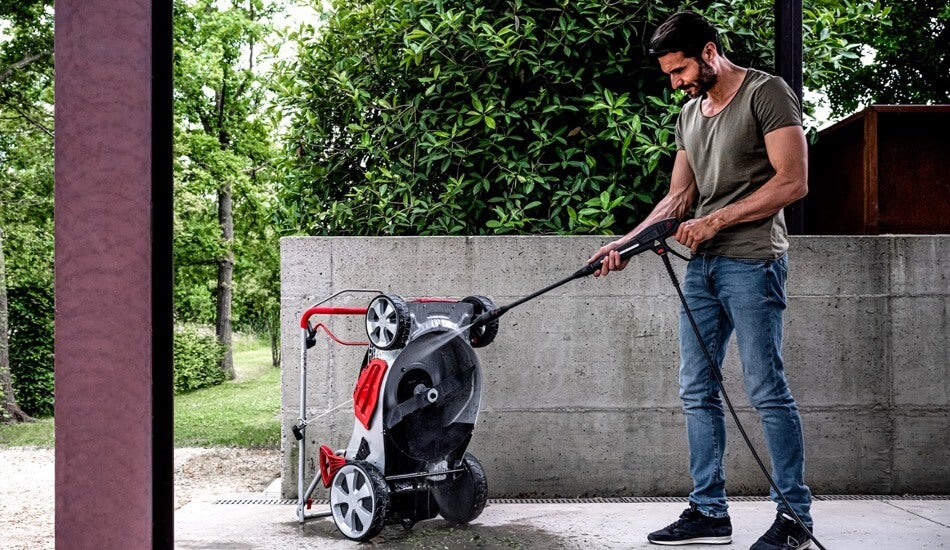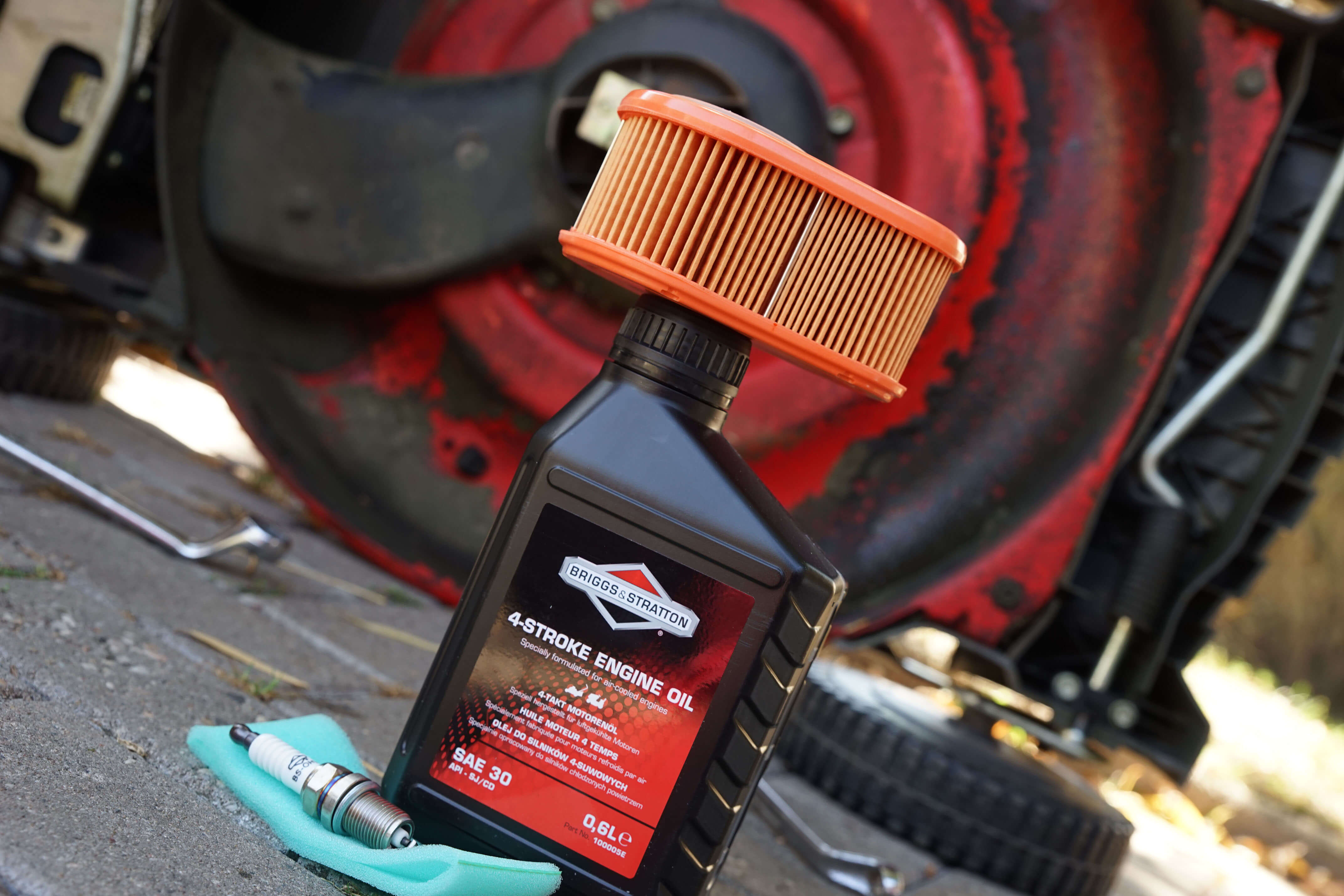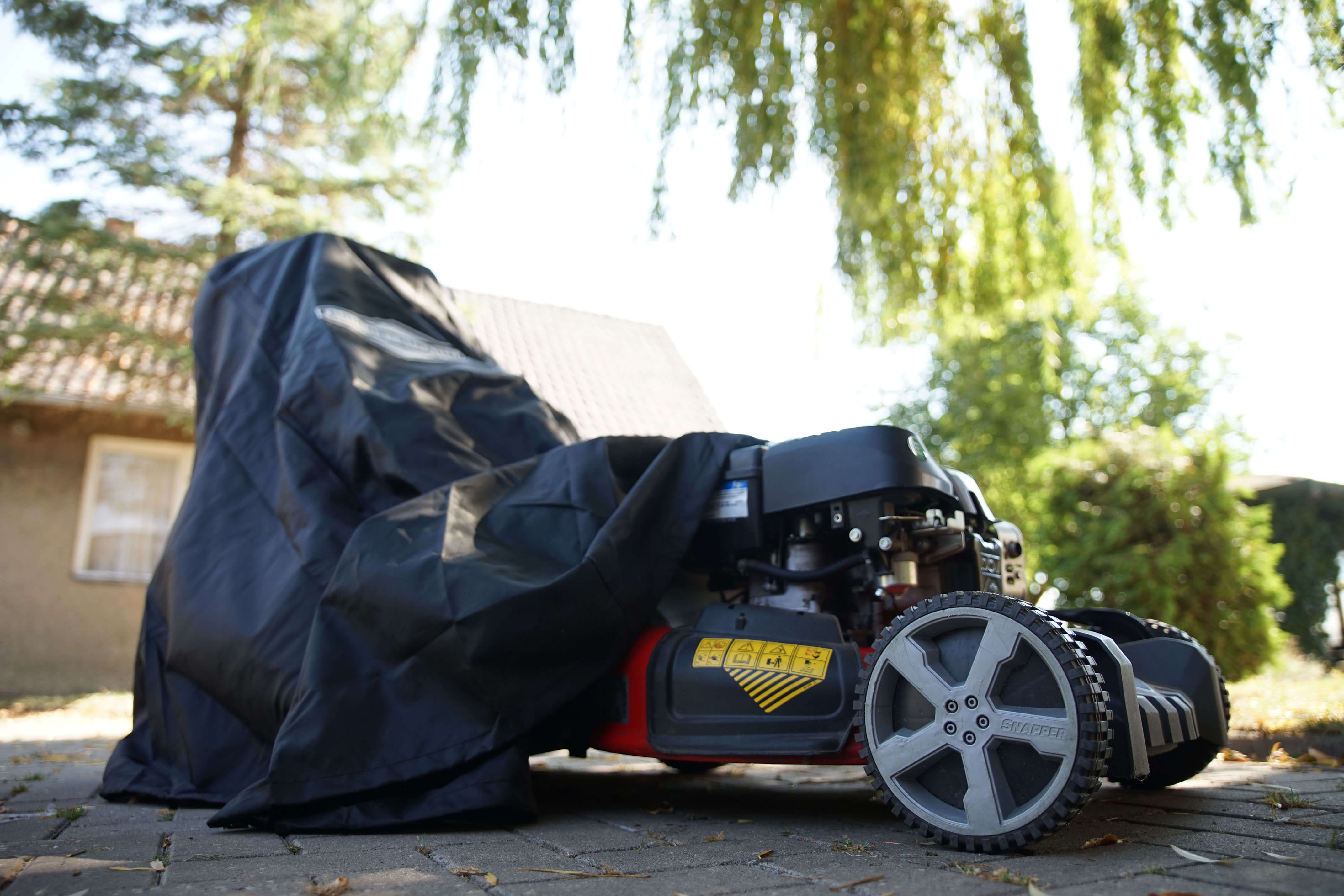9 simple steps for perfect petrol lawnmower maintenance
Straightforward lawnmower maintenance can increase the total lifespan of your petrol lawnmower, so you get the most out of your investment.
Safety comes first!
Before you start with the steps below, carry out some basic safety precautions. Always wait until the blade of the lawnmower is completely stationary. Then pull out the spark plug cap. If you do not do this, there is a small chance that the engine will start again by turning the blade. This is unlikely, because nowadays most machines are equipped with a blade safety switch, but it’s a worthwhile safety check. For your own protection, put on your work gloves. Want to know more about how to protect yourself? Check out your mower's manual for more safety tips.
Step 1: Remove the grass from the machine
Make sure you always clean your machine after every use. Grass residues contain acids that affect the steel deck. The most important part to clean is the area where the blades are located. Remove grass residues and other dirt with a high-pressure cleaner or a hard brush. Clean the top and clear the grass with a hand brush.
 Remove the grass from the machine
Remove the grass from the machineStep 2: Checking the oil
It is not good for the engine to run the machine with too little oil. Therefore it is a good idea to check the oil level regularly. How often should you change the oil? It varies per lawnmower how often the oil needs to be changed. Average maintenance indicates after 50 hours or after each season. Check your lawn mower manual for more precise guidance.
Before changing the oil, turn on the lawn mower's engine for about 10 minutes. This will make it easier for the oil to flow out. Make sure that there is always oil in the machine, even if you don't use it during the winter. In addition to lubricating rotating parts, motor oil also protects against corrosion.
 Checking the oil
Checking the oilStep 3. Clean the air filter
The engine air filter helps to keep debris out of the engine. This is important to prevent overheating. With a clogged air filter, a lawnmower has less power and is therefore less efficient. So, you need to clean the air filter regularly. How? Check the manual of your machine for your specific air filter. A pure foam filter can be washed with hot water and soap, dried, oiled lightly with motor oil and squeezed out. With a paper and foam filter, a few blows and knocks will shake most debris free. The paper element of a hybrid paper and foam filter must not be washed or blasted with an air compressor.
Is the paper element of your lawn mower filter too dirty? Then you have to replace it. When is your filter too dirty? If you knock it out without seeing improvement, it means that it has to be replaced.
We recommend changing the air filter at least once a year.
Check out the air filters
 Clean the air filter
Clean the air filterStep 4. Check the blade
Check regularly under the machine to see if the blade, or knife, is still sharp. Sharpen the knives at least once a year for the best results and check whether it is still in balance. Use a knife balancing device for this. When the blade is not in balance, the blade will vibrate and this can lead to premature wear of the engine. It is important to check whether the blade of your machine is in need of replacement.
Step 5. Check the spark plug
Proper maintenance of the spark plug prevents the engine from sputtering and makes it easy to start the machine. First check that the engine still starts properly. Turn the mower off, and remove and clean the spark plug with a steel brush.
Next, check that the distance of the electrodes is adjusted properly. In the manual of your lawn mower you will find the correct distance from your machine. Is the spark plug no longer working properly? Then it needs to be replaced. Annual replacement of the spark plug optimises the efficiency of the engine.
Step 6. Check the fuel filter
Some mowers also have a fuel filter. Before you start, always check where the fuel filter is located. Wear safety glasses for your own safety. Keep a cloth at hand to hold the filter and to catch the dripping fuel. Assess whether cleaning the fuel filter is sufficient or whether it needs to be replaced. You will recognise this by the fact that you see debris in the filter or that the paper filter is dirty. A fuel filter removes dirt from the fuel, after all.
This simple step means more favourable fuel consumption and less wear to the engine.
Step 7. Clean the fuel tank
Petrol has a limited shelf life. If petrol is not pumped around, it can cause damage to your machine after about 30 days. There are two ways to prepare your petrol tank for storage after the season. The first option is to keep your petrol mower running until the fuel runs out. Option two, which we prefer, is where you fill up the fuel tank completely and add a Stabilizer or Fuel Fit for proper protection. This way you don't have to empty the fuel tank and your lawnmower will be ready for the next season faster.
 Stabiliser products
Stabiliser productsStep 8. Last check
As well as steps 1-7, it is advisable to give your mower a final check to see whether certain parts still need to be oiled. This prevents rust and ensures that all parts run smoothly. As part of this, check that all screws are still tight and have not been loosened from mowing.
Step 9: Make sure you have a good storage place
Once you’ve completed all of the above maintenance steps, store the lawnmower in a dry environment. Humidity means parts can rust or break down. It is wise to cover the lawnmower with a protective cover.
 Protective cover
Protective coverProper maintenance also includes regularly checking your machine for defects and cracks. Good fuel, lubrication, cleaning and timely replacement and inspection. That is the basis for good maintenance. And good maintenance means faster, more efficient, trouble-free mowing.
FINAL TIP: Do you want to get your mower ready for the next season quickly? Get this package from Briggs & Stratton, which gives you everything you need.

